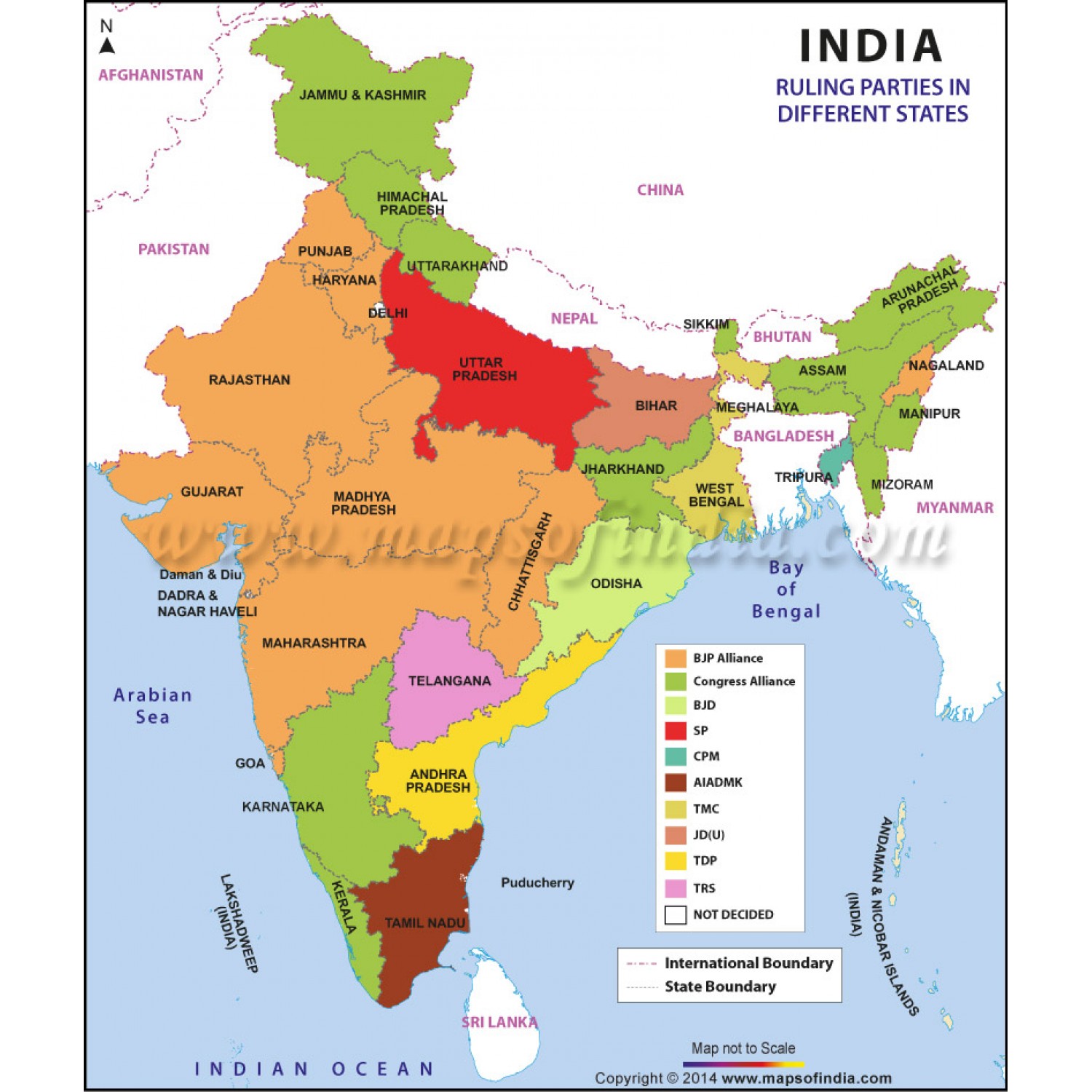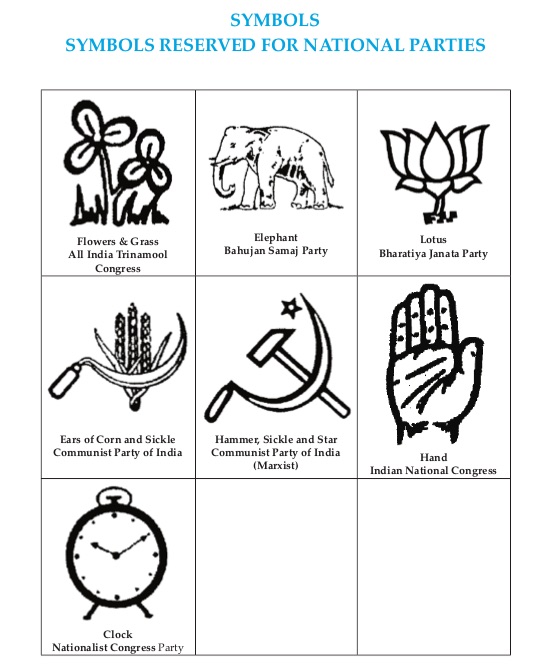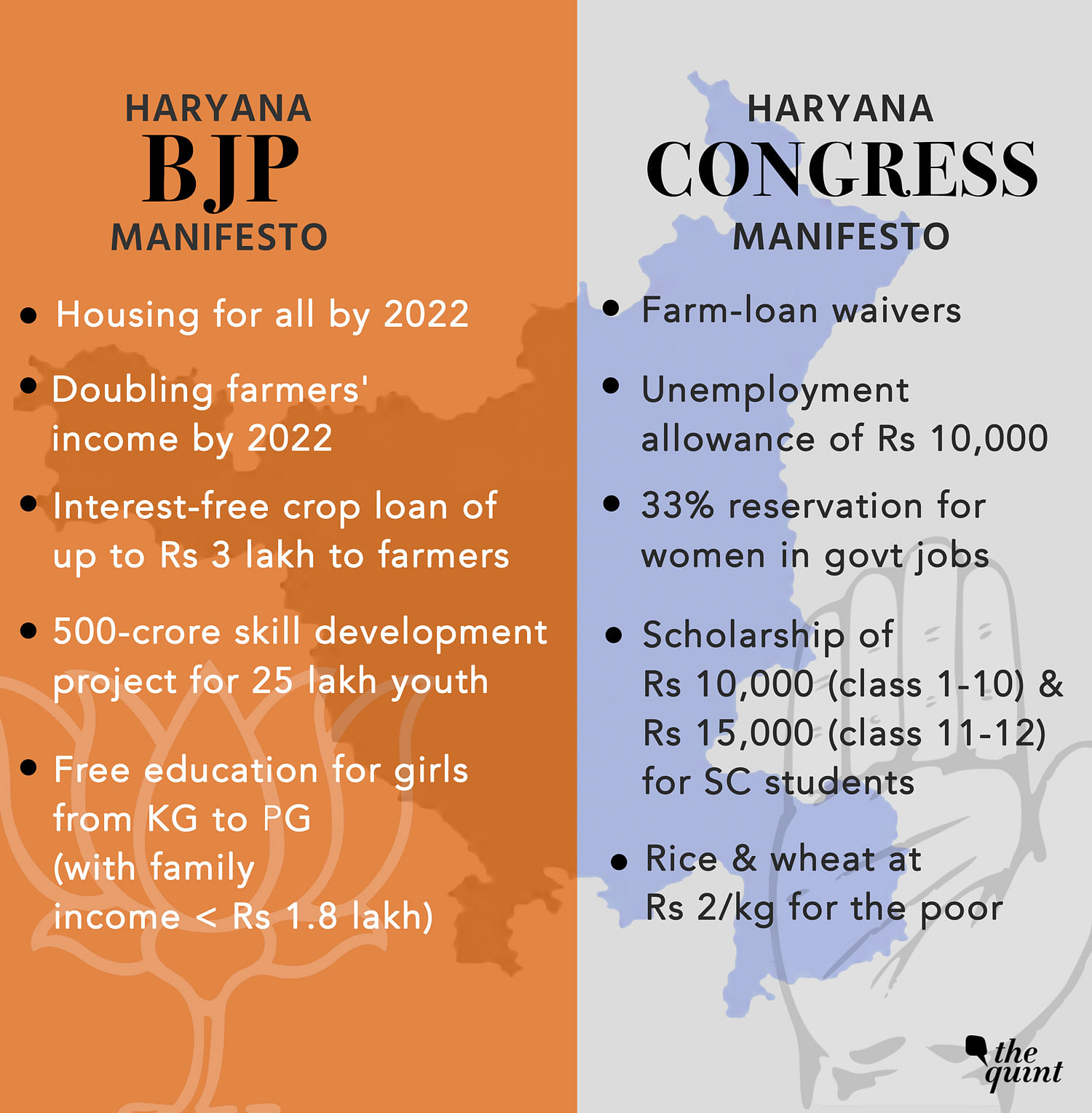August Activity – My Political Agenda
EXPECTED OUTCOMES
- To make the students understand how and why political parties are formed.
- To make the students understand the importance of political parties.
- To make the students understand the functions of political parties.
MATERIAL REQUIRED
Plain sheets, chart paper/coloured paper to make banner and logo for the party (optional), glue, scissors, ruler, pencils, erasers, and sketch pen.
SESSIONS’ OVERVIEW
| S. No. | Activity Process | Time-taken |
| Period 1 | Pre-Activity
Teachers kindly follow guided steps 1, 2 and 3 |
45 min |
| Period 2 | Classroom Main Activity
Teachers kindly refer to steps 4, 5, 6 and 7 |
45 min
|
PRE-ACTIVITY
Period 1
Time required - 45 Minutes
Step 1- Grouping up (10 min)
Step 2- Branding the party (15 min)
Step 3- Party manifesto (20 min)
Step 1- Grouping Up
- The teacher can introduce the concept with a quick discussion on the ruling parties in India. She can show the picture given below (optional). She can discuss the names, political leaders, importance, and functions of the political parties.


The teacher is requested to tell the students that in today's session we will create our mock parties and understand the process of party formation with super fun! So, let us get started by forming groups.
- The teacher can ask students to divide themselves into 4-5 groups depending on the class strength. Let students mutually form their groups. The teacher can guide students in case of any discrepancy.
- The next important thing is to identify your party leader or chairperson and the active members of the party.
- Students can mutually decide on their leader not based on loyalty to a political party but rather based on what is good and right and in the best interest of the nation amongst the group. The group can also identify active members for other key responsibilities and the remaining students in the group can be the followers of the party.
Step 2 - Branding your party


https://newsforkids.net/wp-content/uploads/2019/05/indian-election-symbols.jpg
A) Give the party a distinctive name :-
A political party will be known everywhere by its name, so give this some thought.
- Students will need to select a name that is not already taken by another party and is not so like another one that the public will get confused.
- Select a name that captures the party’s core values.
- Try to keep the name short -- not more than a couple of words. That way, it will be memorable and easily identifiable.
B) Create a meaningful logo identifying your party :-
Logos are used everywhere to advertise and identify political parties. They are typically also required when officially registering a party.
- Teachers kindly tell the students to choose one that is not too complex but is distinctive in meaning.
- Also, the meaning of the logo should be about the party agenda.
- The teacher can quote some examples:
For example, if the party emphasizes conservative principles, you could select a logo that contains a traditional symbol of your area.
If you want to brand your party as an innovator, consider a logo that depicts a modern, contemporary symbol while using traditional colours.
- Students can use sheets, colours, and other craft materials to showcase their party name and logo.
Step-3 Create a manifesto.
A manifesto is a published declaration of the intentions, motives, or views of the issuer, group, political party, or government.
Please ask students to discuss with their party members and make their party manifesto on a sheet of paper.
Students can refer to the image given for guidance.


The teacher kindly take prints of the Manifesto Sample given below to be distributed during the session. If a print facility is not available, please show it on the blackboard to the student groups, students can then make it in their notebooks or blank sheets manually.
A MANIFESTO- SAMPLE
Party Name: _____________________
Party Leader: _____________________
| Party Logo | Meaning of party logo |
Party Agenda Points:
- _____________________________________________________________________
- _____________________________________________________________________
- _____________________________________________________________________
- _____________________________________________________________________
Signature Party leader
Reference link: A Manifesto-Sample
Note: The teacher informs the students that the party leader will present the manifesto in the next class (Students use their creativity and knowledge as a team for the presentation).
Homework:
Teachers can assign the following task to the groups:
Students/party members will help the leader to prepare for the Presentation that the leader has to showcase in the upcoming class.
CLASSROOM ACTIVITY
Period 2
Time required - 45 Minutes
Step 4- Presentation by the leader (25 min)
Step 5- Summary (15 min)
Step 6- Reflection Sheet & Feedback (5 min)
Step 4- Presentation by the leader (2-3 minutes)
The teachers are requested to call each party leader one by one to present the party manifesto in front of the audience/students.
Step 5- Summary
The teacher is requested to make use of the blackboard to display the common points from manifestos presented in the session. Thus, depicting how the students have developed a common line of thinking towards the goal of a better national future.
She will then summarize the activity further and add knowledge related to how parties are formed in India.
Starting a political party is a major undertaking, and you will need lots of support. Figure out your party’s platform at the initial stages, then work to get that message out there through events, social media, and word of mouth. When you have enough members, you can set up the organizational structure of your party. If you meet eligibility requirements, like having enough signatures of support and showing proof that you are organized and active as a party, you can officially register with the electoral commission in your area. Then, your party can really get going by fully taking part in elections and political life.
She will also talk about the financial aspects. It takes money to organize a political party and promote candidates for elections. Your party will need rules for how the money will come in, who will oversee it, and how it will be used. When officially filing your party, you will need to provide a statement of your financial scheme and an explanation of your accounting. She can ask questions like:
- How will donations be generated?
- What account or accounts will the money be held in?
- What guidelines do you want to set for things like how money can be spent on election campaigns?
- What procedures will you have for ensuring financial transparency?
- How will you handle any financial disagreements or investigations?
(If time permits teacher can refer to additional information given in Annexure III).
Step 6- Reflection Sheet & Feedback
Please ask the students to fill up the given reflection sheet.
ANNEXURE-I
HOW TO FORM A PARTY IN INDIA?
- An application for registration is to be submitted to the Secretary, Election Commission of India, Nirvachan Sadan, Ashoka Road, New Delhi-110001 in the Performa prescribed by the Commission.
- The application must be accompanied by the following documents/information:
- A demand draft of Rs. 10,000/- (Rupees Ten Thousand Only) on account of processing fee drawn in favour of Under Secretary, Election Commission of India, New Delhi. The processing fee is non-refundable.
- A neatly typed/printed copy of the memorandum/rules and regulations/Constitution of the Party containing a specific provision as required under sub-section (5) of Section 29A of the Representation of the People Act, 1951 in the exact terms, which reads “—————(name of the party) shall bear true faith and allegiance to the constitution of India as by law established, and to the principles of socialism, secularism and democracy and would uphold the sovereignty, unity, and integrity of India”. The above mandatory provision must be included in the text of the party constitution/rules and regulations/memorandum itself as one of the Articles/clauses.
- A copy of the party Constitution should be duly authenticated on each page by the General Secretary/President/Chairman of the Party and the seal of the signatory should be affixed thereon.
- There should be a specific provision in the Constitution/rules and regulations/memorandum of the party regarding organising elections at different levels and the periodicity of such elections and terms of office of the office-bearers of the party.
- The procedure to be adopted in case of merger/dissolution should be specifically provided in the Constitution/rules and regulations/memorandum.
- Certified extracts from the latest electoral rolls in respect of at least 100 members of the party (including all office-bearers/members of main decision-making organs like Executive Committee/Executive Council) to show that they are registered electors.
- An affidavit duly signed by the President/General Secretary of the party and sworn before a First Class Magistrate/Oath Commissioner/Notary Public to the effect that no member of the party is a member of any other political party registered with the Commission.
- Individual affidavits from at least 100 members of the party to the effect that the said member is a registered elector and that he is not a member of any other political party registered with the Commission duly sworn before a First Class Magistrate/Oath Commissioner/Notary Public. These affidavits shall be in addition to the certified extracts of electoral rolls in respect of the 100 members of the applicant party.
- Particulars of bank accounts and Permanent Account Numbers, if any, in the name of the party.
- Duly completed CHECK LIST along with requisite documents prescribed therein.
- The application along with all the required documents mentioned above should reach the Secretary of the Commission within 30 days following the date of formation of the party.
- Any application made after the said period will be time-barred.
Once you are officially registered, you should be able to have candidates placed on ballots for elections.
Reference link:
How to form a Political Party in India? | Legal News / Law News & Articles - Free Legal Helpline - Legal Tips: Legal India
ANNEXURE-II
Nomination of Candidates –
Any citizen who wants to be a candidate needs to be of a minimum age of 25 years (As we are having a mock party, the age of the students in the class is acceptable).
If anyone has a criminal background, then there are restrictions, but it is applicable in very extreme cases.
Those who get the party's nomination are said to hold a ‘party ticket.’
According to the direction of the Supreme Court, every candidate now must make a legal declaration consisting of following details:
(i) Any serious case pending against the candidate.
(ii) Complete details of assets and liabilities of the candidates and his/her family.
(iii) Educational qualifications.
ANNEXURE-III
How can a political party be funded?
There are various methods of getting a political party funded. The most popular methods of funding political parties, however, are funding by individual persons, open public funding, and corporate funding.
Public Funding or State Funding
State funding or public funding is where the government provides funds to the political parties for election-related purposes. The basic motive behind state funding is to allow a political party to gather funds without approaching companies or people holding money as it often leads to such contributors having undue influence over the political parties they fund. Also, state funding helps save the high amount wasted in election campaigns and provides fair opportunities to political parties having limited sources funding them.
State Funding can be of two types:
Direct Funding: giving direct funds to political parties.
Indirect Funding: other methods except direct funding such as, free access to media, free access to public places for rallies, free or subsidised transport facilities, etc. fall under the category of indirect funding.
Direct funding by the state is prohibited in India. However, indirect funding is allowed in a regulated manner. Some examples of indirect funding in India to the political parties are providing free access to state-owned television and radio network for campaigning, free electoral rolls, income tax exemption under Section 13A of the Income Tax Act, 1961(hereinafter the IT ACT), etc.
Corporate Funding
Corporate Funding corresponds to the funding of the political parties by corporate bodies in India. It has been observed that most of the donations to political parties are made by companies.
Donation by corporate bodies is governed by the Companies Act, 2013. Section 182 of the Act provides that:
‘a company needs to be at least three years old since the date of its existence to be able to donate to a political party,
companies can donate a maximum of 7.5% of the average net profits they made during three immediately preceding financial years,
such a contribution must be disclosed in the profits and loss accounts of the companies,
no contribution shall be made without obtaining the approval of the board of directors by passing a resolution,
if a company contravenes the provisions of this section, it may be held liable to a pay fine which may extend up to five times the amount contributed in default and every officer guilty of such contravention may be imprisoned for a term which may extend to six months and with fine which may extend up to five times the amount contributed in default.’
As evident, corporate funding is a major player in the election campaigns in India. It is a matter of common sense that no company would fund a political party without any personal interest. The more the funding, the more influence the company has over the party. It is for this reason that corporate funding is criticised, and many-a-times has been debated to be banned.
One of the biggest problems in corporate funding is the use of fake companies to flush the black money as donations. It can be prevented if proper scrutiny of all the companies is done regarding their incorporation documents and data available on the website of the registrar of the companies regarding the company in question, verifying PAN details of the company, verifying credit score of the company, etc.
Electoral Trusts in India
Electoral Trust is a non-profit company established to receive voluntary funds subject to Section 29B of the Representatives of People’s Act, 1951 (hereinafter RPA) and donate the same to the political parties (Rule 17CA of Income-tax Rules, 1962). It is prohibited for an electoral trust to carry on any other kind of business. Also, one trust cannot donate to another trust. It is a must for an electoral trust to have “electoral trust” in its name. It is currently provided for by the Companies Act 2013 and Electoral Trusts Scheme, 2013 as notified by the Central Board of Direct Taxes on 31st January 2013.
The electoral trust must donate at least 95% of the contributions to the political parties for campaigning. If it fails to do so, it shall not be exempted from paying income tax. On payment of the said percentage to political parties, it is not required to pay income tax on the donations as provided under Section 13B of the IT Act.
The contributions received and donated by the electoral trusts are very transparent. This, along with the tax benefits, are the main reasons for appraisal of the concept of electoral trusts. Some examples of the companies having electoral trusts are Reliance Group, Vedanta Group, Bharti Group, etc.
Statutory Provisions Allowing Political Parties to Accept Funds
The primary statutory provision regarding funding of political parties is in the RPA:
Section 29B of the RPA entitles the political parties to accept voluntary contributions made to them by any person or company except a government company.
Statutory Provisions Checking and Restricting Donations
The rivalry between political parties in India is aggressive, and it is not a matter of surprise that immoral methods are adopted by certain parties to acquire funds. It includes funding through fake companies, funding through black money and other methods. In order to regulate the fundings, certain provisions are present in different laws in India. Apart from the provisions regulating corporate funding mentioned above, some other provisions are:
Section 29C of the RPA makes it mandatory for the political parties to declare donations received by them from any person or company if such donation exceeds Rs.20,000. Such declaration is to be made by making a report in each financial year and submitting it to the Election Commission. Failing to submit the report on time disentitles the party from tax relief under the Income Tax Act, 1961.
As per Section 2(e) of the Foreign Contribution Regulation Act, 1976, accepting a contribution from any foreign source is completely prohibited. It is punishable with imprisonment which may extend up to five years or a fine or both. Such political party or political representative may lose a seat and be prohibited from participating in elections for a period which may extend up to six years
Reference link: All You Need To Know About Funding Of Political Parties In India (ipleaders.in)



